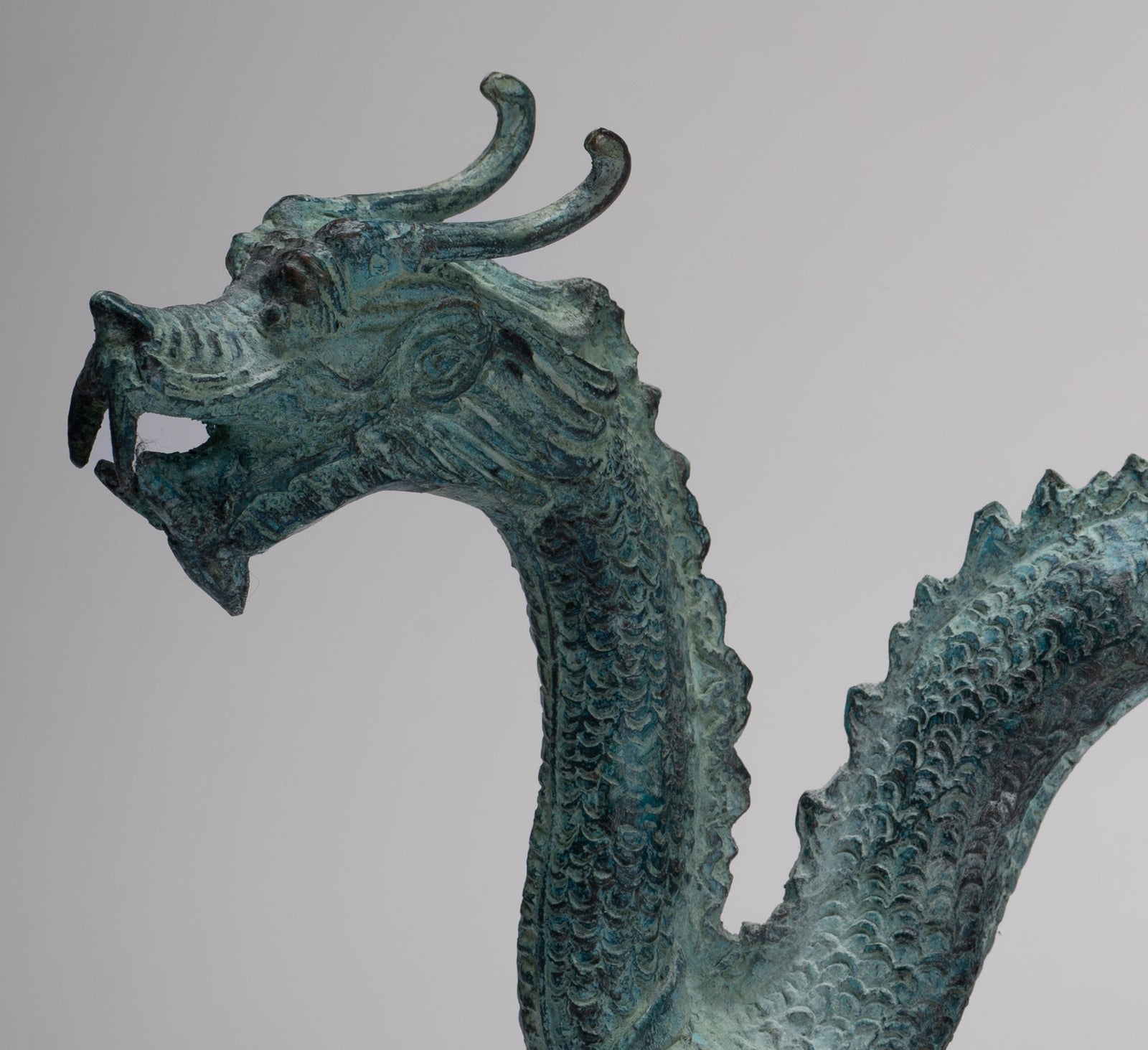
🐉 Dragones en el sudeste asiático: guardianes sagrados en iconografía hindú-budista
Los dragones se encuentran entre los seres mitológicos más duraderos y poderosos en las tradiciones asiáticas. En Sudeste de Asia, los dragones ocupan un papel central en ambos Iconografía hindú y budista, donde son venerados no como monstruos destructivos, sino como protectores sagrados, deidades acuáticas y guardianes cósmicos.
Su influencia se puede ver en tallas del templo, escultura, arquitectura y narrativas espirituales en países como Camboya, Tailandia, Laos, Myanmar, Vietnam e Indonesia.
En el arte religioso del sudeste asiático, dragones, a menudo identificados con el Nāga—No no son solo animales míticos. Representan el Unión de la Tierra y el Agua, el canal de fertilidad y lluvia, y el Protección espiritual del espacio sagrado. Durante siglos, se han convertido en símbolos clave dentro del lenguaje visual y espiritual de ambos hinduismo y Budismo, asumiendo formas localmente distintivas mientras se mantiene los orígenes pan-indic.
🐍 Nāga: el dragón serpentino de la tradición hindú y budista
En el corazón de las imágenes de dragón del sudeste asiático se encuentran Nāga, una serpiente semi-divina que se origina en mitología india temprana.
🕉️ En el hinduismo, Nāgas son:
-
Seres de serpientes celestiales que viven en el inframundo (Pātāla).
-
Guardianes de cuerpos de agua y fertilidad.
-
Asociado con Vishnu (que duerme en la serpiente cósmica Shesha), y Shiva, que usa nāgas como adornos.
-
Temido y venerado, capacidad de destrucción pero también de gran benevolencia.
☸️ En el budismo, Nāgas se convierten en:
-
Protectores del dharma, frecuentemente protegiendo reliquias, templos y seres ilustrados.
-
Los seres sagrados que una vez escucharon al Buda y prometieron defender sus enseñanzas.
-
Símbolos de transformación, fuerza interna, y poder místico.
Una de las características de episodios más icónicas Mucalinda, El rey Nāga que protegió al Buda Meditante de una tormenta envolviendo sus bobinas a su alrededor y extendiendo su capó arriba.
🌏 Localización de imágenes de dragón en el sudeste asiático
A medida que el hinduismo y el budismo se extendieron por el sudeste asiático desde la India, el Nāga se adaptó a formas regionales. Estas transformaciones combinan creencias locales sobre espíritus ancestrales, animismo y adoración de serpientes indígenas con la cosmología india clásica.
Exploremos cómo evolucionó esta iconografía en diferentes culturas:
🇰🇭 Camboya: la nāga múltiple en arte jemer
En Arte jemer, especialmente durante el Período angkoriano (siglo del siglo VIII a 15), Nāgas se convirtió Serpientes de siete o nueve cabezas, a menudo visto:
-
Flanqueante calzadas del templo, formando balaustradas que se parecen a los cuerpos serpentinos.
-
Protegiendo las entradas del templo a Simbólicamente separar el mundo sagrado del secular.
-
Asociado con el Leyenda de la Princesa Nāga Somaque se casó con un brahmán indio y dio lugar al pueblo jemer, haciendo nāgas antepasados míticos del jemer.
Los jemer nāgas son estilísticamente únicos,capuchas ventiladas como una cobra, y están tallados con elegancia y grandeza.
🇹🇭 Tailandia: El Nāga como Templo Guardian y Rain Traer
En Tailandia, los nāgas están siempre presentes en los templos budistas (wats) y folklore:
-
Representado como dragones de serpiente proteger escaleras y tejados.
-
Se dice que viviera en el Río Mekong, particularmente venerado en Nong Khai, donde el Phaya Nāga es adorado.
-
Que se cree que causar rayos, truenos y lluvia, crítico en la cultura agraria de Tailandia.
El Fenómeno de bolas de fuego naga (Los locales atribuyen los misteriosos orbes brillantes que se elevan del Mekong) a estos espíritus de serpientes.
En la iconografía budista tailandesa, las nāgas protegen a los monjes y las estatuas de Buda, lo que significa Tutela espiritual y poder elemental.
🇱🇦 Laos: el nāga como protector de la ciudad y deidad de fertilidad
En la creencia de Lao, los nāgas son espíritus ancestrales y protectores profundamente venerados:
-
Vientiane, la capital, se dice que está míricamente protegida por un nāga gigante.
-
Los nāgas están asociados con deidades del río, crucial para el cultivo de arroz y la prosperidad.
-
A menudo aparecido en Ceremonias baci y tatuajes locales, que se cree que imparte Protección y fertilidad.
El Que Luang Stupa y Parque de Buda Cerca de Vientiane presenta imágenes prominentes de Nāga.
🇲🇲 Myanmar: El dragón como elemento cósmico y de la tierra
En Myanmar, los nāgas y los dragones se han fusionado ligeramente con Chinthe (Guardianes de león), aunque los dragones serpentinos siguen siendo parte del folklore:
-
A menudo se muestra como guardianes de tesoros y escrituras sagradas.
-
A veces aparecen en forma de Makara, una criatura mitológica de crrocodilo, parte-dragón, asociado con umbrales del río.
🇻🇳 Vietnam: dragones imperiales y simbolismo budista
Vietnam dragón imperial (Largo o rồng) Fusiona las creencias indígenas con el simbolismo budista:
-
Visto en Dinastía Nguyen Arquitectura, túnicas imperiales y altares budistas.
-
Un símbolo de poder, protección y autoridad espiritual.
-
El dragón es a menudo más suave y sinuoso que los modelos chinos, que reflejan los gustos estéticos locales.
Aunque menos explícitamente atado a las imágenes nāga, los dragones vietnamitas llevan connotaciones cosmológicas y espirituales similares, especialmente como creadores de lluvia y seres cósmicos.
🇮🇩 Indonesia: Nāgas en Java y Bali
En Indonesia, especialmente Java y Bali, Nāgas están presentes en:
-
Arquitectura Candi (Templo), donde aparecen como Figuras de Guardian, barandas de escaleras o motivos de canales de agua.
-
En Hinduismo balinés, Nāgas como Basuki y Anantaboga guardia santuarios del templo y el saldo cósmico.
-
El Reino de Nāga subterráneo es parte de la cosmología balinesa, que conecta el mundo terrenal con las capas espirituales y del inframundo.
En Arte de la era Majapahit de Java, Nāgas a veces se fusionan con Makara o formas similares a un dragón, asociadas con fertilidad, protección y rituales esotéricos.
🐲 Simbolismo de dragones y nāgas en la iconografía del sudeste asiático
🔹 Agua y fertilidad
Como los habitantes del río y los traficantes de lluvia, los dragones simbolizan fuerzas de vida, Central en sociedades agrícolas.
🔹 Tutela
Escaleras de flanqueo, umbrales y puentes, nāgas representan guardianes espirituales de templos y reinos sagrados.
🔹 Transformación y poder espiritual
Sus cuerpos serpentinos simbolizan el Energía de Kundalini o fuerza vital Eso se eleva a través de la meditación.
🔹 Conexión ancestral
En la tradición Khmer y Lao, los nāgas son antepasados míticos, vinculando la devoción espiritual al linaje y la identidad.
🔹 Orden cósmico
En la cosmología hindú y budista, los dragones representan el Unificación de elementos—Ellidad, agua e incluso fuego - Bringing armonía cósmica.
🛕 Dragones en la arquitectura y ritual del templo
En todo el sudeste asiático, los dragones aparecen en:
-
Dinteles y pedimentos de las entradas del templo
-
Balaustradas naga a lo largo de calzadas o escaleras (Angkor Wat, Wat Phu, Borobudur)
-
FINALES DE TECHO Con forma de serpientes para desviar la mala energía
-
Rituales del festival, especialmente en ceremonias de lluvia o ritos de fertilidad
✨ Conclusión: El dragón como puente sagrado entre mundos
Desde las escaleras del templo de Angkor hasta los techos sinuosos de los tailandeses, el dragón en el sudeste asiático del arte hindú-budista es Sin mero mito—Es un símbolo vivo del sagrado.
Ya sea enrollado en piedra o imaginado en el folklore, el Nāga continúa protegiendo, alimentando y transformando.
Estas serpientes sagradas nos recuerdan que el verdadero poder espiritual a menudo se encuentra debajo de la superficie—Epa en las aguas de la intuición, escondido en el suelo de la tradición, o enrollado en silencio al pie del Buda.
🐉 Explore el arte del dragón del sudeste asiático en HDasianArt
En Hdasianart.com, ofrecemos una selección curada de Esculturas nāga y inspiradas en dragón, desde los guardianes del templo jemer hasta las serpientes cósmicas balinesas.
Cada pieza celebra el elegancia mítica y espíritu protector de estos seres sagrados.
Traiga la fuerza, la serenidad y la resonancia espiritual del legado del dragón del sudeste asiático a su espacio sagrado.


